
Broad band Sky Flat field (disregard the tiny black spots which are dust directly on the CCD surface ;-(
Test on the Sky have been performed to be able to state whether or not this
device is suitable for deep sky imaging (this leads to the most demanding requirement,
after spectroscopy). This had taken place in Feb 2002.
We used a 250mm F3 telescope located in
a place which is not completely light
pollution free. All images were read by the Ethernet-Chungara controller.
Flat field aspect and PRNU
The image hereafter is an unfiltered sky flat field recorded at dawn, with
a 250mm F3.5 telescope. A pattern is
visible : this is the famous blue Marconi diamond pattern (mostly visible in
the blue band).
Why ? Because all the pixels do not have the same Quantum efficiency or response
(so the pattern), nevertheless the dispersion of the pixel to pixel response
(called Photo Response Non Uniformity - PRNU) is limited to 2.5%, which is indeed
really low. This pattern, though well visible even through raw exposures, and
more particularly on a bright sky background, disappears completely after having
cancel out the flat field, like one does for preprocessing the images.

Broad band Sky Flat field (disregard the tiny black spots which are dust
directly on the CCD surface ;-(
Check here a raw image, 30 sec exposure of M81.
Fringing
So far no fringing have been reported during this test on raw images.
Nevertheless, if the sky background is large, the fringing effect could be
hidden. The fringing effect is produced by narrow band IR sky background light
emission. This one is related to many meteorological parameters. To be sure
this effect not to be an issue, a test has to be done in a real dark observing
place.
The sky background, I've got, at the zenith is something about 33e-/pix/sec
(no filters).
By stacking carefully preprocessed images (for instance here, 5 exposures of 120sec each), a slight fringing effect is visible in this high contrast frame (display cuts are very close from each other) :

A faint background pattern is visible, this is the fringing caused by narrow
band sky background illumination at wavelength > 800 nm
This image is the full 1x1k frame, post 2x2 binned.
The fringing effect can be substracted by a master fring frame. The master fringing frame is obtained by taking many images of the sky, with a field as poor as possible, each image are shifted and median stacked to get an image free of stars. Then the image is processed as usuall, so that only the fringing remains. This calibration data is gathered once, or every 6 months.
Dark frame/ dark current
This topic has been already discussed here
As said, the dark offset is easy to be removed and since there is few hot pixels,
there is no need to apply any cosmetic tricks.
Gain in limiting magnitude
Thinned CCDs are supposing to bring gain in limiting magnitude. This is something
I have checked, by comparing the images acquired with the 47-10 and the one
from a classical frontside illuminated device from THOMSON, TH7899M, with the
same telescope and the same place. Unfortunately, this comparison could be be
carried over using a KAF1602E to the sky, because I don't have a this device.
The TH7899M CCD has 14x14um pixel (compared with the 13x13um pixel from the
47-10), that could help the TH7899M to be more efficient in detectivity (depending
on the sky background brightness). But actually, it did not help.
Two field having the same elevation were chosen. (It was not possible to take
the same field), one was in summer, the other in winter.
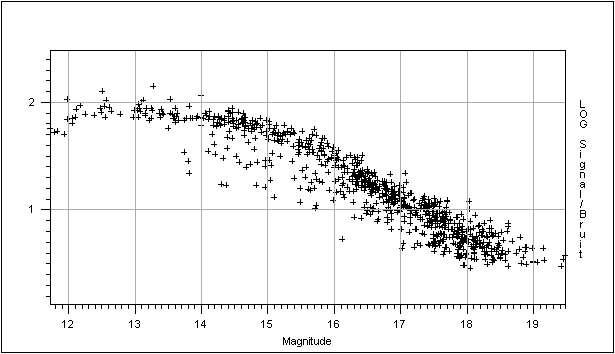
T250, CCD marconi47-10, 120 sec exposure (no filter).
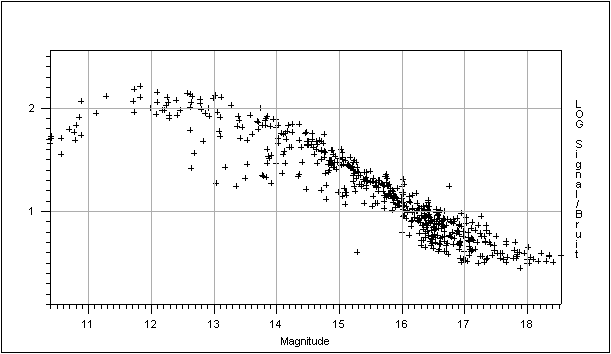
T250, CCD Th7899M frontside, 120 sec exposure (no filter).
The first plot shows that magnitude 19 can be reached in 120s with a Marconi47-10
whereas the CCD TH7899M reached around 18. The CCD TH7899M is a frontside CCD,
its QE can be compared to a non ending "E" KAF series.
Some nice images
Some nice galaxies were recorded with the Marconi47-10, to demonstrate its ability to perform deep sky imaging. Most of theses images are made from 120s basic exposure without guiding (open loop tracking). These are all subset/window from the 1000x1000 full frame CCD (to save you download times) .

NGC 2403 - 5x120s

M82 - 2x120s + Log


Left : M81 - 2x120s + Log
Right : M81 - 13x120s + Halpha Filter 656nm, bandwidth = 10 nm
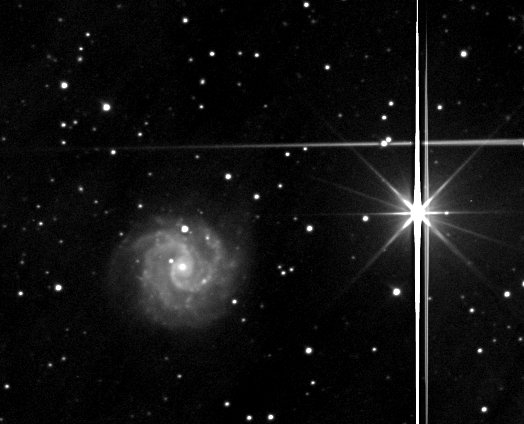
NGC3184, 900s + DDP processing, note the artifact of the blooming, like an
echo some pixels to the left of the blooming, no explainations at that time,
the horizontal trail is a spider effect from a nearby bright star....
The next images have been recorded with a Halpha filter at 656 nm, fwhm=10nm.
The Halpha filter has reduced strongly all the background light pollution, also
including the stars (black body spectrum). The sky background level with the
Halpha filter is 400e- in 120sec, without, it reaches 7000e-. The filter is
extremly efficient for nebula that emit most of their light at 656 nm (Halpha).
Hereafter, look at a single 120s exposure of I434 with Halpha filter, left the
same exposure time of the same object without the filter (simulation): The Ha
light form the nebula dissapear into the sky background (disregard the stars,
just look at the nebula)
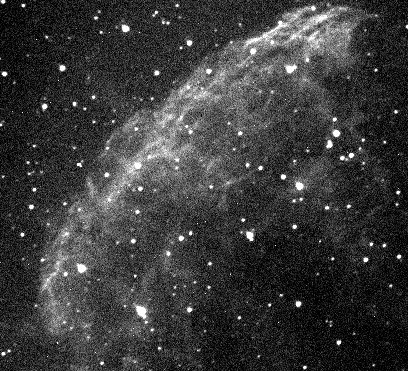
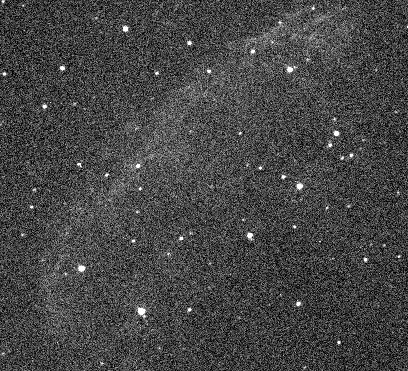
Left IC443,single 120s exposure + Halpha filter, Right, (as simulation) the
same nebula without the Halpha filter
Those images were recorded during horrible light pollution conditions !! Keep this in mind
General comments
The Marconi47-10 is fair to use :
As this device is extremely sensitive, it makes harder to use it on places having high sky background level (suburb areas, for instance I'm leaving 14km north from downtown Munich). The background raises very quickly.
As a conclusion, this device is potentially interesting and performaing well for astronomical low level application, and could be considered for cameras that are able to cool it down properly.
Note : Most of the CCDs used for professionnal astronomy are Marconi-EEV thinned devices.
For FITS/CPA files for personnal investigation, just ask me.
By Cyril Cavadore, all reproduction forbidden without the consent of the author.